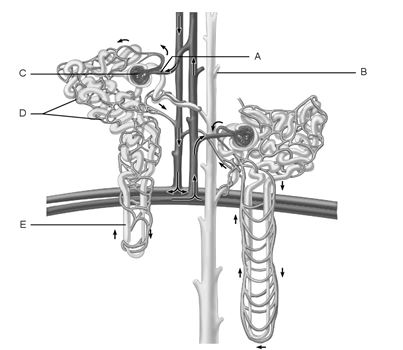Correct Answer

verified
Correct Answer
verified
Essay
Explain how filtration works in the glomerular capillaries.
Correct Answer

verified
The glomerular capillaries are fenestrat...View Answer
Show Answer
Correct Answer
verified
View Answer
Essay
What clinical effects would low blood pressure have on the kidneys of a burn patient?
Correct Answer

verified
This patient would have a much lower glo...View Answer
Show Answer
Correct Answer
verified
View Answer
True/False
Angiotensin II is a substance made by the body to lower blood pressure during stress.
B) False
Correct Answer

verified
Correct Answer
verified
Multiple Choice
The mechanism that establishes the medullary osmotic gradient depends most on the permeability properties of the ________.
A) nephron loop
B) glomerular filtration membrane
C) collecting duct
D) distal convoluted tubule
F) B) and D)
Correct Answer

verified
Correct Answer
verified
Multiple Choice
Which of the hormones below is responsible for facultative water reabsorption?
A) ADH
B) thyroxine
C) aldosterone
D) atrial natriuretic peptide
F) All of the above
Correct Answer

verified
Correct Answer
verified
Essay
Match the following: A) Glomerular capillaries B) Peritubular capillaries C) Efferent arterioles D) Vasa recta E) Afferent arterioles -High pressure vessel that forces fluid and solutes into the glomerular capsule.
Correct Answer

verified
Correct Answer
verified
Essay
Explain how an angiotensin converting enzyme inhibitor (ACE inhibitor) such as captopril would be effective as an antihypertensive.
Correct Answer

verified
Angiotensin II is a potent vasoconstrict...View Answer
Show Answer
Correct Answer
verified
View Answer
Multiple Choice
Which of the choices below is not a glomerular filtration rate control method?
A) renal autoregulation
B) neural regulation
C) electrolyte levels
D) hormonal regulation
F) A) and B)
Correct Answer

verified
Correct Answer
verified
Short Answer
ADH activated water channels called ________ are essential for water reabsorption in the collecting duct.
Correct Answer

verified
Correct Answer
verified
Multiple Choice
Alcohol acts as a diuretic because it ________.
A) is not reabsorbed by the tubule cells
B) increases the rate of glomerular filtration
C) increases secretion of ADH
D) inhibits the release of ADH
F) A) and C)
Correct Answer

verified
Correct Answer
verified
Short Answer
 Figure 24.1
Using Figure 24.1, match the following:
-Nephron loop.
Figure 24.1
Using Figure 24.1, match the following:
-Nephron loop.
Correct Answer

verified
Correct Answer
verified
Short Answer
 Figure 24.2
Using Figure 24.2, match the following:
-Cells that are the most active in reabsorbing the filtrate.
Figure 24.2
Using Figure 24.2, match the following:
-Cells that are the most active in reabsorbing the filtrate.
Correct Answer

verified
Correct Answer
verified
Short Answer
The area between the ureters and urethra is called the ________ in a bladder.
Correct Answer

verified
Correct Answer
verified
True/False
The urethra contains an internal sphincter of smooth muscle.
B) False
Correct Answer

verified
Correct Answer
verified
Multiple Choice
If one says that the clearance value of glucose is zero, what does this mean?
A) The glucose molecule is too large to be filtered out of the blood.
B) Most of the glucose is filtered out of the blood and is not reabsorbed in the convoluted tubules.
C) Normally all the glucose is reabsorbed.
D) The clearance value of glucose is relatively high in a healthy adult.
F) B) and C)
Correct Answer

verified
Correct Answer
verified
Multiple Choice
The chief force pushing water and solutes out of the blood across the filtration membrane is ________.
A) the ionic electrochemical gradient
B) protein-regulated diffusion
C) glomerular hydrostatic pressure (glomerular blood pressure)
D) the size of the pores in the basement membrane of the capillaries
F) A) and D)
Correct Answer

verified
Correct Answer
verified
Multiple Choice
The mechanism of water reabsorption by the renal tubules is ________.
A) active transport
B) osmosis
C) filtration
D) cotransport with sodium ions
F) B) and C)
Correct Answer

verified
Correct Answer
verified
True/False
The entire responsibility for urine formation lies with the nephron.
B) False
Correct Answer

verified
Correct Answer
verified
Short Answer
 Figure 24.1
Using Figure 24.1, match the following:
-Structure most closely associated with granular cells.
Figure 24.1
Using Figure 24.1, match the following:
-Structure most closely associated with granular cells.
Correct Answer

verified
Correct Answer
verified
Showing 61 - 80 of 118
Related Exams